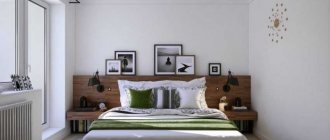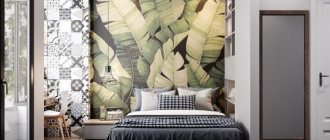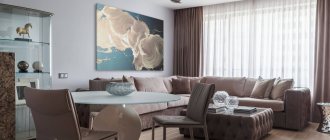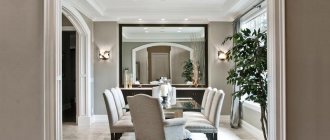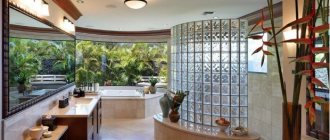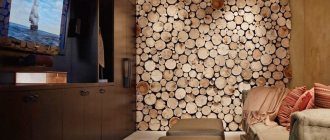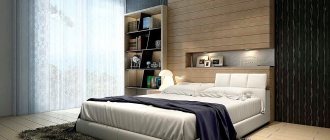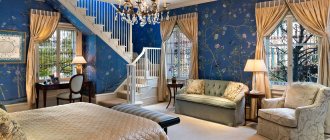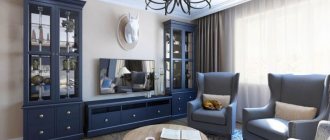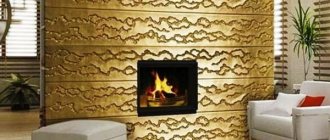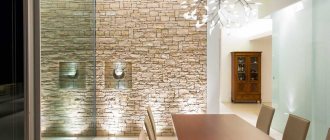Drywall is a favorite finishing material among designers and builders due to its versatility and uniqueness. This relatively inexpensive material allows you not only to quickly and efficiently level surfaces, but also to implement the most daring and non-standard design solutions.
An excellent design idea is a niche in the bedroom.
It is made from environmentally friendly materials, which allows it to be used not only in residential buildings, but also in finishing rooms intended for children. The construction of drywall consists of sheets of cardboard and gypsum dough. The uniqueness of this material lies in the formation of all kinds of geometric designs. Using special technologies, it can be given convex or concave roundness, wavy surfaces, and rounded arches. It is indispensable when creating suspended ceilings, walls, partitions, shelves, racks, arches, niches.
Thus, you will not only add a touch of novelty to the interior, but also acquire a practical decorative element.
Advantages of niche design
All built-in niches in the bedroom differ from each other in a number of parameters: height, depth, material and shape. However, any sufficiently deep alcove has a number of obvious advantages in the interior:
- Additional space is created in the living room, which can be used to maximum benefit. In addition, the design of a bedroom with a niche changes dramatically for the better.
- The alcove at the head of the bed forms a kind of arch that covers the eyes of the lying person from the light of the ceiling chandelier.
- Auxiliary items, modular lamps, souvenir and decorative sets can be located in the niches.
- An alcove with a shallow burial depth can be used for beautiful decoration, for example, mounting panels, mosaic tiles, canvases with photo prints.
- A niche is most often designed as a bedroom, completely repeating the design features.
In deeper niches in the bedroom, rotating furniture structures with a transformation function are installed: wardrobes, beds, desks, folding bar counters.
Wardrobes and armchairs are installed in the alcoves, which can significantly save free space. A closet in a niche in a bedroom is an example of optimal distribution of free space in practice.
Win-win solutions
Essentially, an alcove can be of two types: a deep recess or a built-in decorative structure. The deeper the niche, the more functional and decorative additions can be used. However, you should not abuse plasterboard structures either. Otherwise, an elegant element of the interior can turn into a tasteless, vulgar “sarcophagus”.
In addition to beautiful attributes and souvenirs, the lower segment can be equipped not with open shelves, but with closed cells for storing things. Considering the fact that a niche in the wall is placed in the bedroom directly next to the bed, bed linen and various linen accessories are stored in closed containers.
To make massive structures look light and sophisticated, wardrobes and plasterboard structures are complemented with mirrors, as well as LED lighting and other similar elements. If shelves are placed in a niche, some of them are made of glass, which makes the structure weightless.
The complex design of niches involves the use of a wide variety of decorative elements and finishing materials. The most popular options: textured plaster, photo wallpaper, 3D trellises, inserts made of various materials.
Types of niches by depth
One of the most important technical parameters for an existing construction niche is its depth. After all, focusing on the distance to the back wall, you can think over the layout of furniture in the bedroom interior. The following types of construction alcoves are distinguished:
- True niches. These structures are fairly deep alcoves in the wall in which any objects, devices, or furniture can be placed. Bedrooms with a niche for a bed are very practical.
- Decorative models. The depth of such buildings is minimal, and therefore the niche is used exclusively for room decoration.
There are also artificial niches in the bedroom, which are made from plasterboard or other building materials. A similar approach is used for beneficial zoning of the bedroom.
In "Khrushchev"
The most ambitious thing is redevelopment, but this is the only way to implement a similar design in a Khrushchev-era bedroom. It is interesting to use recesses in old apartments as niches. However, old walls require separate restoration.
- If a small niche is being restored, it would be correct not to highlight it with color, but to paint it in the same shades as the wall;
- a decorative niche, which includes several small shelves, can be united by a common frame;
The layout of one-room apartments sometimes provides a niche, next to which you can make a cozy bedroom. Plasterboard structures that combine the functions of a closet, shelves and bed are very good for arranging a corner. For this purpose, plasterboard partitions are installed. Fenced area 6 sq. m. Enough to place a bed. Such small rooms provide scope for design ideas. The walls are decorated with mirror surfaces, you can install a sliding partition, and use wallpaper in contrasting colors for decoration.
Types of niches by other parameters
Designers identify several more parameters by which a construction alcove is assessed: shape, height, number of tiers. Today, quite a few varieties of decorative and true alcoves have appeared:
- From floor to ceiling.
- At a certain distance from the floor level.
- Single alcoves (without division into tiers).
- Multilevel models. Decorative items, miniature table lamps, and souvenirs can be located on each floor.
According to their shape, all niches are divided into classic rectangular, semicircular, trapezoidal, elongated or square alcoves.
Optimal material for installation
Among all the variety of materials offered on the construction market, the most convenient and easy to use are plasterboard sheets. Fragility and fear of water are their main disadvantages. They have a smooth surface that is easy to process - putty, paint, wallpaper.
Before you go buying drywall, let's get acquainted with its variety:
- Arched;
- Wall;
- Moisture resistant;
- Fire resistant;
- Ceiling.
The thickness of the plasterboard is 12 and 9.6 mm. For the strength of the structure being built, we choose thicker sheets. Moisture resistant or wall, depending on the humidity level.
Ceiling - the thinnest. It is cheap. It will also work for cladding.
During the installation process, you will need profiles to ensure structural rigidity and self-tapping screws for attaching drywall to the posts and guides of the assembled frame. We study various photos of options for placing the bed in a niche, draw a working drawing, and make an estimate.
In this regard, the layout of the bed in a niche made of plasterboard is the best economical option. You can do without expenses, and spend the saved money on purchasing finishing materials.
Niche design rules
For apartment owners, the reliability and quality of the repairs carried out are an important criterion. For this reason, a number of rules for finishing a construction alcove should be followed:
- Before starting repair and finishing work, you should decide on the purpose of the future structure. For example, compare the dimensions of the TV and the connector itself intended for installation.
- Particular attention is paid to the quality of interior finishing. All surfaces are leveled and covered with a layer of antifungal and antiseptic composition.
- For lighting fixtures, care should be taken to ensure power lines.
- All wiring must be hermetically sealed to avoid possible moisture ingress and short circuits.
Special requirements are placed on artificial niches, which craftsmen make with their own hands from various materials.
All construction work should be presented in advance in the form of a drawing, which will allow the work to be carried out without gross errors. They also carefully select the shape, size and external design for a homemade frame that forms a niche.
Decoration
The last stage - decorating the structure - can be called the most exciting and interesting from a design perspective. The most popular finishing materials: Traditional wallpaper (non-woven fabric, vinyl, paper, rice canvas, and bamboo);
Also, with the help of skillfully selected finishing (both in color and texture), it is convenient to enhance the quality of lighting fixtures. This applies to both general lighting in the room and local lighting.
The selection of finishing materials is carried out taking into account the overall interior concept. The dimensions of the structure also play an important role. Large, massive plasterboard niches are best decorated with light wallpaper. Miniature structures can be generously decorated with “heavy” finishing materials: brick-like, glass beads, complex mosaics.
Source
Interior finishing options
Today, a wide variety of interior finishing models for building niches are available to craftsmen. All finishing materials are available at any hardware store at reasonable prices. At the same time, the master will have to take into account the complexity of the design, the cost of the material, and the future design.
Sheathing
The necessary elements are cut out from plasterboard sheets using jigsaws or a special knife. If an alcove is formed for a TV or other equipment, it is necessary to lay the wiring in advance, hiding the wires inside the structure.
Then the niche is plastered. A special tape is applied to the joints, which will strengthen the structure. At corners it is recommended to use special elements to ensure alignment.
Screw heads and other specific elements are puttied with special care. Before applying finishing materials, the entire surface of the recess is carefully primed.
Decorative plaster
A niche covered only with decorative plaster has an advantageous design. The walls, bottom and ceiling of the alcove are white and blend perfectly with other interior features.
In addition, this finishing method does not require special skills and abilities, and the material is adequately durable. Before applying plaster, all surfaces must be coated with 1-2 layers of primer, which will increase the adhesion of the plaster to the underlying wall.
Features and Benefits
You can entrust the installation of a niche in your bedroom to professionals, but it is not difficult to cope with it without outside help. A few sheets of drywall, profiles and a successful project - and now you can already plan what to place on the shelves at the head of the bed. The niche can easily house an entire library or exhibition of family photos in its depths. It will also take on the functions of a rack for souvenirs, replace a bedside table and become the best place to place the TV. The advantages of plasterboard construction are:
affordable price for materials; quick installation; safety and environmental friendliness; the ability to create original forms; light weight structure.
The niche is designed according to the general concept of the bedroom interior. Niches made in oriental style look especially interesting, when they languidly contain a spacious bed with small decorative pillows.
Liquid wallpaper for a niche
An alternative option for interior decoration of a construction alcove is liquid wallpaper. Modern compositions have a beautiful design, pleasant texture, and wonderful color combinations.
Thanks to its special consistency, liquid wallpaper makes it possible to mask small defects on the surface of the walls. The advantages of using it include an environmentally friendly composition that is absolutely safe for humans.
Decorative painting
For those who do not like interior decoration and large-scale renovations, there is an alternative option - stencil painting. For this purpose, a set of stencils (sets of PVC films) and acrylic paints are used.
The surfaces of the niche walls are pre-coated with plaster or liquid wallpaper. After the coating has completely hardened, you can proceed directly to the design of the alcove.
This method is especially popular for decorating children's bedrooms, because with the help of paints and a brush you can draw a whole fairy-tale plot in the room and create a fascinating atmosphere.
Films with imitation of various materials
For an interior style such as Loft, brickwork is often used. However, the dimensions of the niche do not allow the use of real brick due to its volumetric dimensions.
In such cases, you can resort to special PVC films with imitation of various materials: brick or masonry, wood, tiles. The films are easily attached to the underlying surface, tolerate wet cleaning well, and do not fade under the influence of sunlight.
Placement methods depending on the design style
Currently, it is encouraged to place several recesses in one room at once - of course, if its dimensions allow this.
They can be placed:
- symmetrical to each other;
- asymmetrical;
- combined.
The latter option is still rarely used in design projects, although it accumulates the strongest decorative potential. Symmetrical
located niches are a sign of an interior that has been carefully designed to the smallest detail, in which there should be no surprises.
The dictates of strict geometry are more suitable for modern design styles: loft, contemporary, Scandinavian minimalism
. Calibrated lines, absence of any curves, brevity and effectiveness in one bottle.
The reasons for such popularity of such architectural solutions lie in their applied nature: in the design styles mentioned above there is no room for anything superfluous - every detail of the interior must be justified, every square meter must be organized.
Space optimization as one of the trends of not only this year, but also next year in action. Sequentially placed recesses in the wall and in the classic format feel quite comfortable, but this is rather an exception that directly confirms the rule. As for asymmetry
, it usually characterizes interiors in
Provence, shabby chic, and vintage styles
.
There is a predominance of forms rounded at the top and framing. An interesting detail: most often, paintings, family photos, archaic vases and other objects
, which directly hint at the taste preferences of the owner.
Practical use of a niche
Decorative niches are used for decorative finishing of the bedroom. For example, a small arch has an interesting design, inside of which there are mosaic tiles, stone and brickwork. Inside such frames, panels of bamboo wallpaper are attached, and various stylish frescoes are glued. True and artificial alcoves are used for more practical purposes.
Non-standard application
You can refuse to purchase cabinet furniture for the living room, replacing it with a very interesting and functional design. Decorate one of the walls in the room with decorative niches and shelves where you can place a TV, home library, flower pots, favorite family photos, children's toys, and many household items. A variety of niche shelves will fit perfectly into any room of your home - be it a bedroom, a children's room, a kitchen or a hallway. Such designs help organize space and often become the main accents in rooms.
Very interesting solutions can be implemented with conventional wall cladding. Drywall allows you to make almost any imitation. You can, for example, lay out an entire brickwork in a room, replacing heavy sand-lime brick with light plasterboard. In a large and spacious bedroom, you can build real columns: this way you can turn an ordinary room into palace chambers. You can remove all the doors in the apartment: leave the arched openings and decorate them with curtains with a lambrequin.
In large rooms, two-level plasterboard ceilings with hidden lighting will look great. If you build an additional niche in such a ceiling to install a curtain rod, which will be invisible, you will create an amazing feeling that the fabric is flowing directly from the ceiling. If the room is also provided with interesting lighting, it can create a mysterious and enchanting atmosphere. You can install a box with original lighting on the wall.
TV installation
Construction niches located on the wall opposite the bed are used as a platform for TV and music speakers.
If the size is sufficient, shelves or holders for disks and flash cards can also be installed there. However, it is worth remembering that a TV in a niche in the bedroom requires high-quality protection from moisture.
Creating a Closet
With enough space, a niche can be used for storing things and for decoration. Excellent options are offered by florists - plants decorate the top of the cabinet.
It is worth making a barbell from artificial material that will be used to hang things on hangers.
You can achieve an interesting result by creating shelves located at different levels.
Ways to decorate a niche
Any construction niche is a full-fledged piece of furniture in the bedroom, and therefore requires mandatory decor. There can be a variety of options for how to decorate a niche in the bedroom:
- Fresco mosaic, which is used to decorate decorative niches.
- Large-scale painting on the surface of the wall (alcove).
- You can place spotlights around the perimeter of such an alcove, and hang a mirror on the wall itself. This niche serves as an original boudoir.
Using a number of practical tips from experienced designers and original designs (available on web portals dedicated to interior design), you can get a profitable alcove. This design has maximum practicality and fits perfectly into the bedroom design.
What is required to create plasterboard niches?
In order to correctly calculate the required amount of materials, you need to understand what degree of complexity the future structure will be. It is necessary to take into account the number of future shelves in the niche, as well as lamps, so the final estimate will largely depend on these indicators.
To complete the work you will need the following tools and materials:
- plasterboard sheets for the desired surface (arched or wall);
- guide and fastening profiles for gypsum boards;
- “P” - shaped bracket;
- dowels;
- corners for decorating the corners of the structure (can be replaced with ribbon);
- putty;
- pencil and tape measure;
- scissors for cutting metal;
- drill;
- putty knife.
If you have no experience in such work, then when calculating materials it is better to make a small reserve so that during the repair process you will not be distracted by additional calculations and shopping trips.
